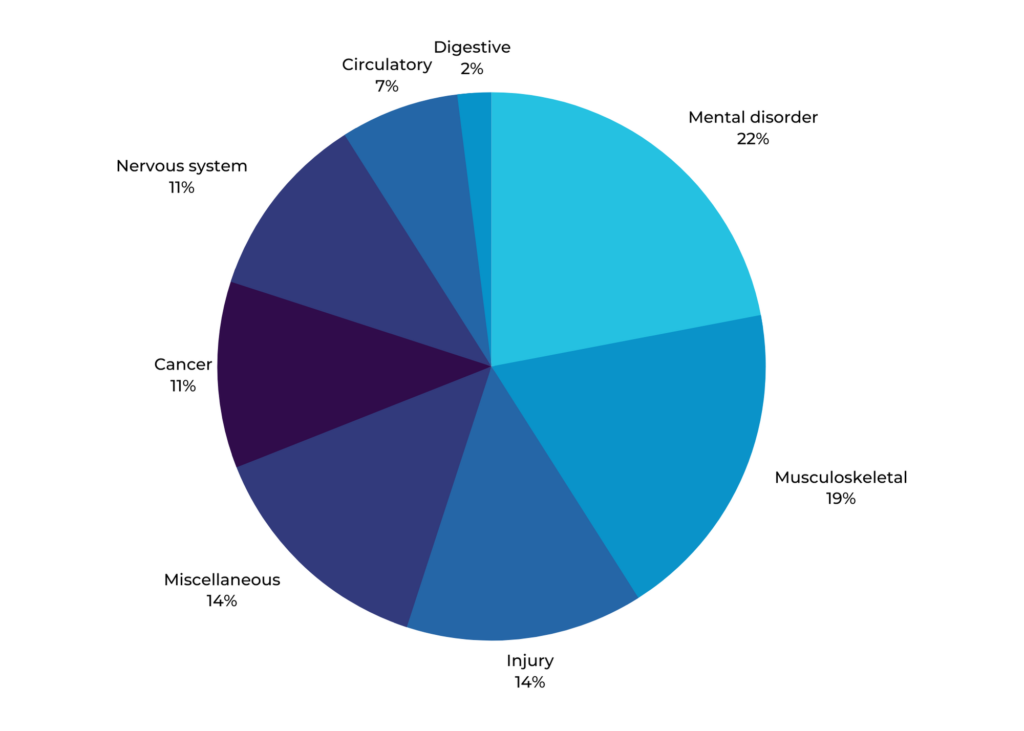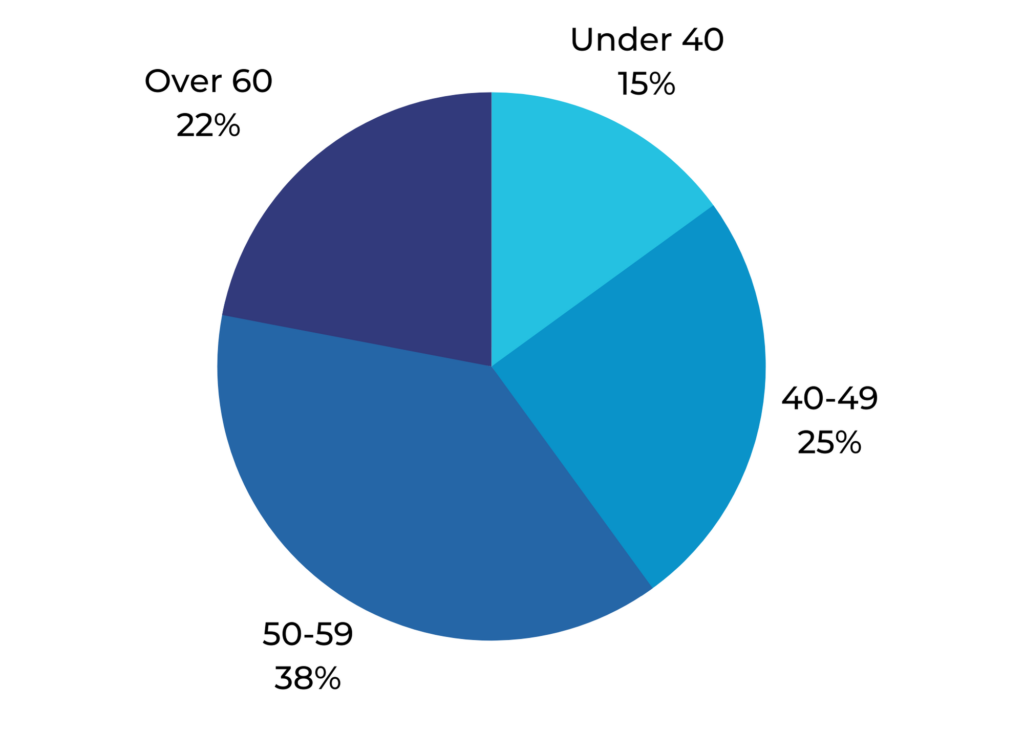Table of contents
Disability insurance can serve as income replacement if you can’t work due to an injury or illness. While anybody with gainful employment should have coverage, nobody wants to go through a disability claim.
But statistics show one in three people become disabled for 90 days or longer before 65. So if you’re wondering how to make a disability insurance claim, this post is for you.
- The leading causes of disabilities are medical conditions like mental health and musculoskeletal issues.
- Once you submit the required documents, the insurance provider will assign a claims examiner to your case.
- If approved, you will receive insurance benefits at the end of the month after completing your waiting period.

Disability Insurance Claims Statistics
Long-term disability insurance pays out a monthly benefit if you’re unable to do the main duties of your job due to an illness or injury. You can use the tax-free disability income to pay medical expenses, as income replacement, or as you see fit.
When it comes to disability insurance claims, you may think that accidents make up most of them. However, as the statistics show, that is not true at all. In fact, injuries only account for 14% of all disability claims.
Medical conditions are the leading cause of claims. Mental health issues like depression and anxiety top the list with 22% of all claims. This is followed closely by musculoskeletal problems like back pain, neck pain, and carpal tunnel syndrome, which account for 19% of claims.

Disabilities don’t discriminate based on age, either. Although most disabilities occur in the 50-59 age bracket, other age brackets make up a large proportion of claims too. This underscores the need to get disability insurance while you are young and carry it throughout your career.

How To Make A Long-Term Disability Insurance Claim
Being disabled can be a scary thought. You’re going about your business working and enjoying life when all of a sudden, you lose your ability to earn an income. The first thoughts that come to mind are making a full recovery and getting back to work, but now you also have to worry about applying for disability benefits.
That’s why insurance companies try to make the disability claim process simple. Its representatives will work with you to ensure they have all the information to make a quick claim decision. Their goal is to exercise sound judgment and fair handling of your case. They also want to ensure accurate payments and prompt settlement to minimize your income interruption.
Here are the steps you will go through.
Notify the insurance company
The first thing you need to do is to notify the insurance company within 30 days of your disability. That way, it knows about your disability and can send you the claim forms without delay. You can also obtain a claim form from the insurance advisor who sold you the policy.
As you are aware, there is a waiting period before disability benefits begin. This is how long you have to be disabled before receiving benefits. Waiting periods range from 30 to 730 days, but 90 or 120 days is most common. That’s why you want to be proactive in notifying the insurance provider so that you receive benefits on time.
Complete claim forms
The claim forms contain a package with separate sections for you, your attending physician, and your employer to complete. It also has a section for you to authorize the insurance company to gather more information if necessary. Essential information on the form includes:
- Date your disability started
- Place of any hospitalization or medical treatment
- Name and addresses of attending physicians
- Cause of the disability. Is it an accident or sickness?
- Place of employment at the time of disability
- Diagnosis, treatment, and prognosis for a return to work
- Copies of any consultation reports and test results
After receiving the claim forms, you’ll want to complete and submit them within 90 days.
Acknowledgement
After receiving the claim forms, the insurance company will assign a claims examiner to your case. It will confirm receipt of the claim forms within 10 business days.
The claims examiner will be your contact for the claim. It will handle your case from start to finish, evaluate your claim, and arrange for payment if the claim is approved. On top of that, it will also work with you on a rehabilitation program so you can return to work quickly.
The main advantage of the claims examiner is that it will be your main point of contact. It will know the key details of your claim so you don’t have to deal with multiple representatives from the insurer.
What Happens After You Claim For Disability Benefits?
The claims examiner will review your claim in the weeks following receipt of the claim forms. Then it will make one of the following decisions.
Approve the claim
The claims examiner may contact your attending physician and other doctors to better understand your situation. If it determines that your condition prevents you from performing the essential duties of your job, it will approve the claim.
The insurer pays the disability benefits at the end of the month after you satisfy the waiting period. So if the waiting period is 90 days and you became disabled on May 20, the first payment will be deposited directly into your bank account on August 31.
Approval is just the first step. You will need to provide updates on your medical condition at various intervals throughout your claim. This proves you still qualify for the ongoing disability income.
Besides the disability benefit, the insurance provider may also pay for a rehabilitation program. Helping you return to work is a benefit for both parties. For the insurer, it avoids the costs of a long-term claim. As for you, returning to full-time work means you will earn more than your disability benefit.
Approve the claim with further benefits to be considered pending more information
The claims examiner may approve the initial disability benefits, with additional payments pending receiving additional medical information. This is usually the case if the disability extends beyond the normal recovery period.
The insurer may also need more information when the definition of disability changes. For example, your insurance policy may use the regular occupation definition for up to two years of disability. That means the insurer will pay you disability benefits if you’re unable to work in your own job.
After that, it changes to the any occupation definition. Disability income stops if you can do a different job than when your disability started, for which you qualify based on your education, experience, and training. Therefore, the insurer will make sure you still qualify based on the new definition of disability.
Request more information
If the claims examiner determines that the information on the claim forms is insufficient, it will contact your attending physician. Ensuring your physician responds promptly avoids delays in receiving benefits.
Additional information will also be required for residual disability claims where the amount payable is proportional to your income loss.
Claim not accepted
If you do not meet the definition of disability as set out in the policy, you won’t qualify for disability insurance benefits. The insurer will send you a letter outlining the reasons for the decision. If you disagree with the decision, you can appeal it.
The claim is denied and the policy is rescinded
If you misrepresented any material facts on the application including medical and financial information, the insurance provider may void the policy. Once your policy has been in force for two years, the insurer can only rescind the policy if it can prove the misrepresentation was fraudulent.
How To Make A Disability Claim From Other Sources
Other sources of disability benefits exist besides private long-term disability insurance. Here is a brief summary of how to claim for each source.
Group long-term disability benefits
Group insurance is the coverage you get from your employer or association. The process for claiming group insurance is like an individual disability policy. The difference is that you’ll notify your employer’s human resources department, which will help supply the required documents.
One of the benefits of group insurance is that it often includes short-term disability insurance. So you can start getting disability income much sooner than you would with your personal insurance policy. Benefits usually start within days or a few weeks of the onset of a disability.
Employment Insurance (EI) sickness benefits
Another source of short-term disability insurance is EI. It provides disability benefits for up to 15 weeks. In 2022, you can receive up to $638/week. If you are self-employed, you have to enroll in EI manually.
To get Employment Insurance sickness benefits, you can apply on its website.
Canada Pension Plan (CPP) disability benefit
CPP disability benefits provide long-term disability insurance benefits until age 65. You can receive benefits up to the maximum amount of $1,457.45/month in 2022, and this amount is indexed to inflation every year. Also, your dependent children may be eligible for a monthly benefit.
Similar to Employment Insurance, you can apply for CPP disability benefits online. It can take up to four months to make a decision, so apply early to avoid a lengthy income interruption.
Workers' Compensation
Worker’s Compensation provides disability benefits for workplace injuries and illnesses. Each province administers its own program, so you have to consult with the Workers’ Compensation in the province of your residence to find out how to submit a claim.
Have Questions About Claiming Disability Insurance Benefits?
Disability insurance coverage is the most important thing you can get for income protection. But while you need the coverage, the last thing you want to do is make a claim.
Navigating a disability claim can seem like an overwhelming task. Coordinating everything can be a nightmare with so many parties and documents involved. Fortunately, the claims adjuster and your advisor will guide you through the claim process so that you can focus on recovery.
For more resources on claiming disability benefits, contact us at info@briansoinsurance.com or 604-928-1628. If you need a long-term disability insurance quote, please complete the form below.
Get Your Disability Insurance Quote Now
While we make every effort to keep our site updated, please be aware that timely information on this page, such as quote estimates, or pertinent details about companies, may only be accurate as of its last edit day. Brian So Insurance and its representatives do not give legal or tax advice. Please consult your own legal or tax adviser. This post is a brief summary for indicative purposes only. It does not include all terms, conditions, limitations, exclusions, and other provisions of the policies described, some of which may be material to the policy selection. Please refer to the actual policy documents for complete details which can be provided upon request. In case of any discrepancy, the language in the actual policy documents will prevail. A.M. Best financial strength ratings displayed are not a warranty of a company’s financial strength and ability to meet its obligations to policyholders.

No comment yet, add your voice below!